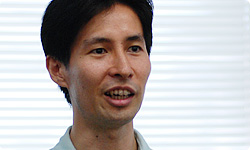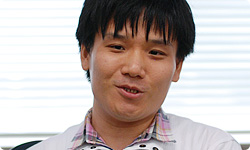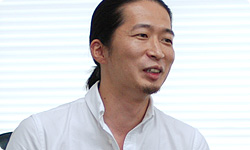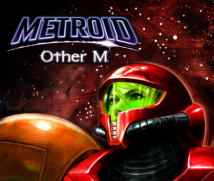2. Biggest Cinematic Production Job
After the news came that you would be developing Metroid: Other M, Team NINJA members, while perhaps still feeling that it was happening to someone else, or thinking ‘no way!’, ‘why us?’ or ‘this is like a dream’, actually got to meet the Nintendo staff. What were your impressions when you first met them?
To be honest, I was scared of meeting them. I’d heard some stories going round that Sakamoto-san was a really stubborn person, you see... (laughs)
Yes, he certainly is stubborn about his obsessions. (laughs)
(laughter)
That’s why I was really worried, thinking ‘I wonder if it’s going to go well...’. I honestly felt that I’d hate working in a ‘top-down’ kind of system, being told to ‘do this, do that’. When I actually met them, however, it was really... How should I say... They really talked to us like we were on the same level. Everybody we talked to – not just Sakamoto-san but all Nintendo staff – made us think the same simple thing after talking to them for a little while: ‘Doing this together seems like it would be fun’.
That’s exactly how it was. We’d make a proposal, saying ‘this is what we can do’, and Nintendo would give a response such as ‘no, we’d like to do it like this’. At first glance this seems like a conflict of opinion, but actually we really felt that their way of thinking was just the same as ours regarding the things we ultimately valued, and how to improve through the process of achieving these things.

Could you give us some specific examples of these shared ‘things we ultimately valued’?
I really felt we were on the same wavelength on points such as ‘how to display the Metroid world’, and also on how to make the player feel simple things like ‘you know, this is really fun to play...I want to keep playing, and keep moving Samus around, so I can enter the game world more’.
How was it for you, Otsuka-san?
I could really feel their obsessiveness towards the game, especially Sakamoto-san. He’d be so frank with us if he thought something was no good. He wouldn’t express himself harshly, though...
So he’d give it to you straight, but kindly? (laughs)
That’s right. His appearance suggests as much as well, don’t you think?
Yes, he really is just the way he looks. (laughs)
(laughter)
That’s why I was a little shocked at first.
He’s just the same within the company, though. Everyone around him is exposed to his outright rejections on a regular basis. (laughs) It’s a completely different world, but even when he was making the light-hearted WarioWare10 series he was always ready to axe any minigame which didn’t reach the standard, saying ‘this one’s no good’. 10 The WarioWare series of games are compilations of several instant action minigames. So far, a title from the series has been released for every system, including WarioWare, Inc.: Mega Party Games!, WarioWare: Touched! and WarioWare: Smooth Moves. The first game in the series, WarioWare, Inc.: Minigame Mania was released in Japan in March 2003 and in Europe in May 2003. Sakamoto was the producer.
His axe really comes down hard! (laughs)
Yes, he won’t compromise about things like that. But when he axes something, he does it with integrity, so you always know ‘at least he’s not saying he dislikes me personally’.
Oh yes, that’s right. I could feel how much he loves games, and I’m really grateful to him for telling us straight-up, in a way that’s easy to understand, that ‘this part is no good, but this part is great’. Some of the exchanges I had with Sakamoto-san, in particular, made a deep impression on me. About two years ago, for example, during the early stages of development, he said ‘I want to add the Sensemove to FPS mode11 as well’. 11 FPS stands for ‘first-person shooter’, that is, a shooting game played from a first-person view.
You mean he wanted the player to be able to evade enemy attacks even when controlling the game using the pointer on the Wii Remote?
Exactly. Whatever we tried though, we just couldn’t implement the camera nicely. Just as we were searching around for various solutions, Sakamoto-san had a ‘lightbulb moment’ and came up with an idea. ‘You’ve done this before and it worked, so we should be able to do it here as well, right?’, he said. He was talking about using the camera system that Team NINJA had specialised in – the kind of solution that Team NINJA would normally think of.
That must have been a big shock for you! (laughs)
Yes, it was an enormous shock! (laughs)
It’s like your neighbour pointing out the flowers that are blossoming in your own garden, isn’t it?
That’s exactly right. I remember it vividly even now. I was so mortified that I couldn’t even sleep that night. Then, when we actually tried implementing it in the game, it fitted beautifully, which was even more mortifying... That was my most painful experience during the development.

(laughs). But you can always make use of experiences like that the next time. Okay, now I’ll ask Nagasawa-san, who was in charge of cinematic production. When I questioned Kitaura-san about this in the last ‘Iwata Asks’ session, he said that his response when he heard that TECMO and Nintendo were working together was Iwata Asks - Metroid: Other M. What was your first impression, Nagasawa-san?
Exactly the same as Kitaura-san’s! (laughs) As you mentioned before, Iwata-san, from my outsider’s perspective I thought that the two companies were polar opposites. Furthermore, when we had our very first meeting, the only document we had was the scenario that Sakamoto-san had written, so I was in a situation where I felt ‘what are we supposed to do here?’.
So you started from a position where you didn’t know what was being asked of you?
That’s right. I would have understood a simple request such as ‘I want this scenario made into a movie’, but this was a video game, of course, so I really didn’t know which parts to make into cinematics, or how to go about doing it. Even when I met Sakamoto-san, he spoke fervently about his scenario and his enthusiasm was really infectious, but the question ‘what am I supposed to do?’ was still left unanswered.
How did things change from that initial ‘what am I supposed to do?’ situation?
After a while, we received a guide to the scenario’s composition, indicating ‘this part will be a cinematic, this part will be gameplay’. After seeing that guide, we finally realised that ‘this is going to be an awful lot of work’ – a realisation that, little-by-little, became more concrete.
So you gradually came to see the volume of things you had to create?
Well, we couldn’t see it that clearly. We did realise that the volume was way too much, and thought ‘first off, this looks like it’ll be tough’, but we just couldn’t imagine how the game parts and cinematic parts were going to be fused together. Though it’s a very irresponsible thing for me to say as a creator, I thought, ‘we’ll never know until we try making it...’

That’s quite a thing to say! (laughs) You’ve been working in cinematic production for many years. Among the projects you’ve worked on, was the scale of this project especially big?
Yes, this project easily stands out as being the biggest one I’ve worked on. So even though we’d decided to try making it first, we couldn’t turn the scenario into cinematics until it had been made into storyboards.
Creating the storyboards was Kitaura-san’s responsibility, wasn’t it? He told me that it took him six months to finish them all.
That’s right, so I was practically signing off my emails to Kitaura-san with things like ‘Please create the storyboards soon’ or ‘How are the storyboards coming along?’ the whole time.
Like an editor getting on an author’s back, then. (laughs)
Yes, and as a result, replies from Kitaura-san became rather few and far between! (laughs) While he might have been silent, however, the storyboards he created had more impact than I could ever have imagined. I actually panicked a little bit, thinking ‘Making all of these will be a herculean task’.
Because you had to think about things like how to take every shot and create every cinematic?
Yes. In the end though – and this is something else that’s rather irresponsible to say as a creator – I thought, ‘ah, I’m sure it’ll be fine’. (laughs)
I see. (laughs)
Since Kitaura-san put all his energy into creating the storyboards, we were able to really react to that feeling and proceed by putting maximum effort into the cinematic production.
